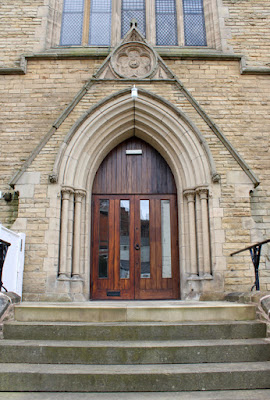 |
| The entrance to Highfield Library |
The day after my trip to Attercliffe, to photograph its listed buildings, I received a message from Harrison Cameras to tell me that the official Canon Service Centre in the UK had declared my Canon Powershot G16 camera irreparable – because replacement blades for the sticking shutter were no longer available.
Knowing very well that certain tried and tested components in VW cars, for example, have not been changed for decades, I have to say that I wasn’t impressed by this response – especially since my new Canon EOS 2000D, to ‘upgrade’ my 10 year old 400D and bought 'blind' during the COVID-19 Pandemic when no face to face service was available, wasn’t performing as expected.
After looking at a couple of Canon Powershot cameras, one of the very helpful Harrison's staff managed to get the shutter blades working again, which postponed my immediate need for a replacement compact camera, I set off up London Road to start another good walk around Sheffield - to further photograph the stonework in its historic buildings.
Having surveyed the stonework of the Sheffield Board Schools in Walkley, Manor, Heeley and Carbrook, along with various churches in Crookes and miscellaneous lodges and houses in and around Norfolk Heritage Park in Sheffield S2, my knowledge of the geology and building stones of Sheffield had improved considerably over a period of 3 months.
Arriving at the Highfield Trinity Anglican and Methodist Church, which sits at the junction of London Road and Abbeydale Road, my first thought that this might be another use of the Crawshaw Sandstone – with its uniformly buff colour, well defined bedding planes and relatively thin courses.
Without seeing documentary evidence or if the stone has immediately recogisable characteristics, I can’t make more than an educated guess at is provenance and I have to say that, knowing very little about the work of the architect John Dodsley Webster, I don't have any idea of the materials that he favoured.
From a distance, I could see that the dressings to the north-west facing main door were very different in colour to the walling and, crossing over the road to examine it more closely, I didn’t recognise the distinctly cross-bedded gritty sandstone that has been used here.
Built 1877-1879, there would have been access by rail to the best sandstones in Derbyshire and West Yorkshire, with which I am quite familiar, but I can’t recall ever seeing such a pattern of differential weathering in any of these sandstones.
Before crossing back over London Road, I took a few quick snaps of the ornate doorway on the front of Highfield Library by E. Mitchell Gibbs, who was responsible for many of Sheffield's prominent buildings - including the nearly identical Upperthorpe Library, which also has figurative sculptures flanking the entrance and was built in 1876.
On the corner of London Road and Sharrow Lane, I then stopped to take a few quick snaps of an unlisted building that was once the National Westminster Bank, where carved heads - possibly sea gods and goddesses - adorn a simple band course on the first floor.
A Sheffield crest, wiith crossedarrows and sheaves and the dates 1831 and 1909, appears above the door surround which, along with the plinth, is made in Ross of Mull granite – a decorative stone that was favoured by very many Victorian and Edwardian architects.
 |
| A crest and Ross of Mull granite at 254 London Road |
I then set off up towards the former Sharrow Lane Sheffield Board School, but stopped immediately at No.1 Sharrow Lane to take a close look at this former bank, now an Italian restaurant. This was built in a Beaux-Arts style in c.1910 and provides another example of Ross of Mull granite for the columns and larvikite for the pilasters, which form part of the semi-circular portico.











Interesting. Thanks.
ReplyDeleteIt's good to see these buildings standing well, though with change of use. The Italian restaurant was my first bank, the Library was my favourite hunting ground, St Barnabas and Trinity were on opposite sides of the road, testament to the factions present in Christianity in those days. The Anglicans had the better choir, but the Methodists showed better films!
ReplyDelete